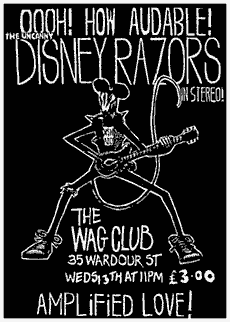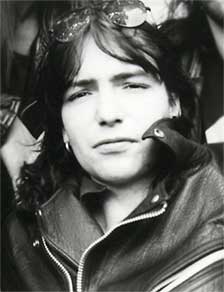
![]()
 Buy 750kg maximum breakdown here
Buy 750kg maximum breakdown here
THE RECORDING OF '750 KG. MAXIMUM BREAKDOWN'
What's perhaps most remarkable about the Disney Razors near legendary debut album '750 kg. Maximum Breakdown' is that it saw the light of day at all.
The story of its recording and release is a cautionary tale in producing a blistering epic of sex, drugs, death and rock n roll, followed by a step by step guide in how to keep all the furious energy and aural mayhem a secret!
Insuring that the album is known only to the most dedicated of loyal followers, the people who were actually there, and being there is what the record is all about.
Twelve tracks written in blood,by four rockers born without the brakes on, with no particular place to go except harder, faster, more.
This is how they did it.
Firstly the title, an apparently obscure reference which one could be excused for thinking referred to its creators' state of mind, or to quote 'Abandoned Here', the closing track on side one:
'How far can too far go? I don't know…'
The name 750kg in fact came from the weight overload plate in the elevator of the dilapidated tower block in Battersea, London, where guitarist Guy Christian White was living and was chosen by the bands close confident and some time manager Russ Marx who was to introduce Paul Barton (of whom more later) to the act .
The flat belonged to Guys girlfriend and was being used as a combination crash pad and shooting gallery. The White brothers having blagged a battered four track cassette recorder and were demo-ing songs using Guy's '57 Les Paul Junior and the first of a long line of begged, borrowed or stolen Watkins' Copicat tape echo machines.
Many of the songs from this period remain unreleased, some having been laid down only in outline form. The guitar itself was bought and paid for from Guy's first term grant check at a fine art course. It would be the only term he would ever complete.
The guitar itself would be the only possession he ever really owned.
Adam and Guy had played in one band already, a four piece with Adam playing bass but they became frustrated by what the singer was doing with their material. The cracks were beginning to show when events took a course of their own and the singer had a breakdown in New York .
The band over they went back to the tower block and continued writing, and, at the right time and the right place Adam met drummer Roy 'Rock' Fullbrook, and the Disney Razors were underway.
Rock was, at seventeen a veteran of several previous bands having already made his first recordings aged twelve on the Crass label drumming for Home For Hangmen.
It was immediately a meeting of like minds, and the White boys and Roy became brothers. Roy knew a rehearsal space in Hoxton, the Leisure Complex run by Steve Honest. Honest was just starting his own recording studio, and the Razors were again in the right place at the right time. Bassist T.J. 'Clyde' Brickell, age eighteen, answered an ad in Melody Maker, and the band was ready to roll.
Recording conditions at the Leisure Complex were primitive by today's standards, though no more so than other small studios of the time. The equipment was basically an eight track Revox, a mixing desk, and attitude. The band had plenty of that. Honest had plenty of that, plus a way of getting performances down onto inch magnetic tape.
Steve brought all his recording ingenuity to bear on the project, realising that sometimes the simple thing work best. The concrete stairwell between two sweatshops became the perfect echo chamber for creating a real ambient sound that the band could play in. Recordings were done hot, as much as the tape could take, then more. And live, the band worked best live, so tracks went down onto tape with as little variance from their live sound as possible. Steve juggled the levels to get the maximum overdrive out of the instruments and amplification.
It wasn't an exact science, but then true alchemy rarely is. The band wrote, went into the studio, and laid the songs down, in late night sessions, picking up dead time that Steve squeezed out of the schedules of other paying customers. The first session produced three tracks, 'Two Minutes Later', ''Stay Upright' and 'Let It Go'.
Cordelia Records of Leicester, home of Peel show favourites The Deep Freeze Mice, liked what they heard, and included 'Two Minutes Later' as the opening track on the compilation Obscure Independent Classics Volume Three. Airplay on Radio One followed, and Cordelia Records boss Alan Jenkins suggested that if the band could come up with an album, he'd release it.
'Two Minutes Later' is a good example of where the band were at the time, literally two minutes and five seconds of furious, non stop, no brakes rock n roll. The song was a slice of real life, recounting Guy's dealings with the Chelsea Drug Squad and 'The Big Key' they frequently used to gain access to his flat above the Up All Night restaurant on Fulham road. The time of drugs had begun in earnest.
I was feelin' good, I was gettin' by
'Bout half past nine, I was getting' high
Lookin' forward to quarter to ten
Two Minutes Later the law broke in….
Grabbing what available free studio time they could, The Razors embarked on a frenzy of recording, live gigs and the circus that was and is life in a rock n roll band. Tracks were written, recorded and discarded with scant regard to an overall pattern, or what should be included on the forthcoming album. Sessions were planned, the decided upon numbers then being pushed aside by songs that had been written the same day and were more in favour, at least for the moment. The moment was all that counted, the here and now right now, the rush of it all.
The best gigs to play were squat parties- later hours, crazier people, no restrictions, and it was obvious from the start that the Razors weren't built to go big business. In fact they never even thought about it. Starring in their own lives was all they needed, and meant that their default position “no compromise” not only possible, but compulsory.
Steve Honest did his best to capture their anarchic energy in any way he could, doing live sound for the band, producing the recording sessions, and playing guitar, lap steel and keyboards on some tracks as well.
Recording in blocks of three or four songs progressed, interrupted by various incidents which came to characterise the history of the Razors. Fuelled as they were by alcohol, drugs and a sense of overall madness, this was bound to happen. Recording was halted halfway through when Roy was stabbed in the heart at a party. Guy narrowly avoided jail on several occasions, moving from flat to flat to escape the attentions of the drug squad. By this time nothing seemed out of the ordinary, and the band rolled on, leaving behind a trail of thrashed venues, trashed equipment and wasted friends.
Razors gigs were unpredictable, with a sense that anything might and probably would happen. It often did.
But when they got the mixture right, they could tear a place apart for all the right reasons, and this is what their fans loved about them. They didn't just take chances, they lived it, and this ethos is reflected in the songs which make up '750 kg. Maximum Breakdown'.
Not working to any perceivable game plan, the band kept on recording. Then Cordelia Records decided they couldn't put the album out themselves, but would see that it was released through Loughborough based Heliotrope records. The band and Steve discussed the track listing endlessly, finally coming up with a running order everyone could agree on.
Some songs were left off because they simply didn't fit. Others failed to make the cut for other reasons. 'Blood Is Blood', which is pretty much as close to a statement of intent, the Razors' raison d'etre, never made it because Guy never finished his vocal. Early numbers, like 'Halfway Down', didn't sit well with the later recordings.
Artwork for the sleeve was made up, the notorious lightning flashes on the original was the design of Adam's current Swedish girlfriend. Other girlfriends contributed too, including Roy 's double act of American girls, Big Tits Kim and Pizza Kim. The first provides back up moans on 'Cut Me Loose'. The second became a fixture during the late night recording sessions, punctuating conversations with her familiar cry of 'I wanna pizza!', a lament the band took to imitating when anyone was hungry.
There always seemed to be an audience at these recording sessions, people variously providing drink, drugs, wit, wisdom, and above all, atmosphere. The Razors liked to party, and if sessions were sometimes an excuse to entertain their friends, then so be it, that's the way it should be.
Musician friends added contributions too, notably Steve Counsel of the London Cowboys, who put down harmonica and guitar tracks, and keyboard player Mark Segal who was present for most of the early sessions.
The album was mastered by Steve Honest at Abbey Road and delivered to Heliotrope for release. An inexperienced company, the label had trouble with both distribution and press releases, insuring that '750 kg. Maximum Breakdown' remained a well kept secret.
Although reviews in the U.S. were good, such was the state of chaos within the Razors' organisation a proposed tour of America never happened. Which meant nothing to the Razors. They just wanted to do it, which meant living it. And live it they did.
They were never in any doubt about what they were doing, any more than when Guy tattooed the word 'Deathtripper' on his own arm, using a biro and razor.
They kept on playing and recording the songs that would make up the lost 'Tijuana Bible' tapes, doing what mattered to them most, living the moment. Rock n roll lives are not clean and neat and tidy, and nor is '750 Kg. Maximum Breakdown'.
But it is written in blood.
 Guy Christian White.
Guy Christian White.